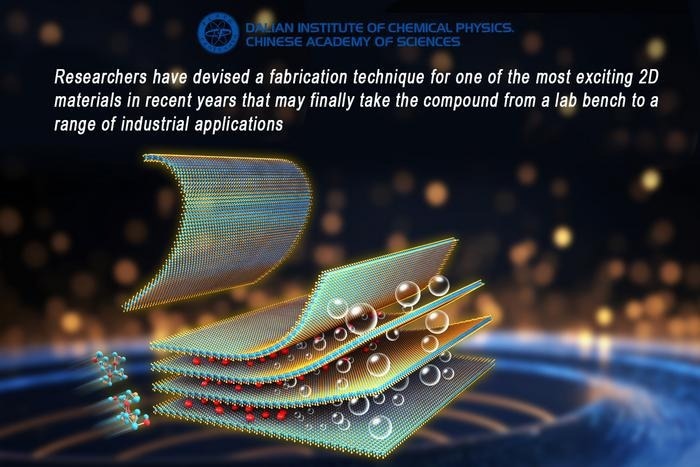Reviewed by Lexie CornerApr 4 2024
Transition metal telluride nanosheets hold tremendous potential for various fields, yet mass production has remained unattainable, relegating the material to a laboratory novelty rather than an industrial asset.
 Researchers have devised a fabrication technique for one of the most exciting 2D materials in recent years that may finally take the compound from a lab bench to a range of industrial applications. Image Credit: Dalian Institute of Chemical Physics.
Researchers have devised a fabrication technique for one of the most exciting 2D materials in recent years that may finally take the compound from a lab bench to a range of industrial applications. Image Credit: Dalian Institute of Chemical Physics.
A recent breakthrough introduces a novel fabrication method. By utilizing chemical solutions to exfoliate thin layers from their parent compounds, a team of researchers successfully produced atomically thin sheets, paving the way for the realization of this ultra-thin substance's potential.
The researchers detail their fabrication technique in a study published in Nature on April 3rd, 2024.
Due to their particularly unusual properties, transition metal telluride (TMT) nanosheets have recently excited chemists and materials scientists in the field of ultra-thin or “two-dimensional” materials (that is, those consisting of a single layer of atoms).
These compounds, composed of tellurium and elements in the “middle” of the periodic table (groups 3-12), exhibit diverse states, including semi-metallic, semiconducting, insulating, superconducting, and even more exotic states. They also display magnetic properties and possess unique catalytic activity.
Numerous possible uses in the fields of electronics, energy storage, catalysis, and sensing are made possible by these qualities. Due to their high conductivity and large surface area, TMT nanosheets are being investigated as novel electrode materials in batteries and supercapacitors, essential for the clean transition.
Lithium-oxygen batteries can benefit from the use of TMT nanosheets as electrocatalysts, which increases the batteries' performance and efficiency. Hydrogen production, photovoltaics and thermoelectrics, filtration, and separation are other possible uses in emerging technologies. Even more intriguing quantum phenomena like giant magnetoresistance and quantum oscillations have been observed in them.
The list of industries that would enjoy significant efficiency improvements from the mass production of TMT nanosheets is extremely long. This is why this 2D material is potentially so exciting.
Zhong-Shuai Wu, Chemist and Team Leader, Dalian Institute of Chemical Physics, Chinese Academy of Sciences
Unfortunately, maintaining high crystallinity while achieving large nanosheet size and ultrathin features remains a significant challenge, even after multiple attempts at exfoliating high-quality TMT nanosheets. The lengthy processing times of the existing methods prevent them from being scaled. They frequently need hazardous chemicals as well. As a result, the properties of TMT nanosheets have remained intriguing laboratory phenomena that have yet to transition to mass production and industrial application.
Through a streamlined method of lithiation, hydrolysis, and, ultimately, nanosheet exfoliation, the team was able to solve this issue in the end.
First, chemical vapor transport (a technique frequently used in chemistry to move solid compounds from one place to another using a carrier gas) was employed to create a bulk quantity of metal telluride crystals. When the reaction vessel is heated, the transporting agent vaporizes and takes the solid compound in vapor form.
As the vapor passes through the reaction vessel, it might come into contact with a colder surface, in which case the compound might settle and crystallize. This makes it possible to grow the desired compound in crystals or extremely thin films under control.
In this instance, lithium borohydride is combined with the prepared telluride crystals. In this process, an intermediate, “lithiated,” compound is formed by sandwiching lithium ions between the layers of the metal telluride crystals.
After that, the lithiated intermediate compound is quickly soaked in water, causing the lithiated metal telluride crystals to be stripped into nanosheets in seconds. This process is known as “exfoliation.”
The metal telluride nanosheets that have been exfoliated are gathered and analyzed in terms of size and shape. This enables them to be further processed into various forms, such as films, inks, and composites, contingent upon the intended use.
The entire process, including the lithiation and hydrolysis, only takes ten minutes. With very high yields, the technique can produce high-quality TMT nanosheets of different desired thicknesses.
The researchers tested the nanosheets and discovered that they were promising for use in micro-supercapacitors and lithium batteries due to their charge storage, high-rate capacity, and stability.
Although they feel that their method is ready for market adoption, they still wish to conduct additional research to better understand the characteristics and actions of their nanosheets and to improve and optimize the lithiation and exfoliation processes.
Journal Reference:
Zhang, L., et al., (2024) Metal telluride nanosheets by scalable solid lithiation and exfoliation. Nature. doi.org/10.1038/s41586-024-07209-2